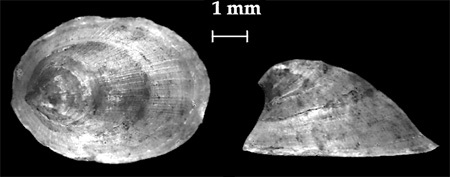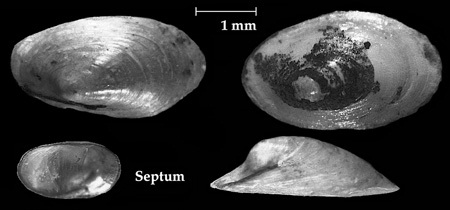FAMILY: ANCYLIDAE
This family of freshwater limpets is represented in Europe by two genera, Ancylus and Ferrissia. The family has now been amalgamated with the Planorbidae on anatomical grounds, but it is considered separately here by reason of the conchological similarity to Acroloxus lacustris.
GENUS: ANCYLUS O.F. Müller, 1773
Only one species occurs in northern Europe – A. fluviatilis. The animal is sinistral; although there is no hint of this in the adult shell, it is shown by the coiling in the embryonic shell, and by the fact that the anus and genital orifice are on the left side.

Ancylus fluviatilis O.F. Müller, 1774
Ancylus fluviatilis O.F. Müller, 1774
Description: The shell shape approximates to that of the traditional Chinese hat. There is no hint of spiral coiling, but the spire arches backwards and is inclined to the right. The shell is thin and lighthorn coloured, with radiating striations and fine growth lines. The aperture is oval.
Size: Height: 3.5 - 5 mm. Breadth: 4.5 - 6.5 mm. Length: 6 - 8.5 mm.
Habitat: It is found in rivers, canals and lakes, throughout the British Isles, adhering to any suitable clean, hard substrate. It prefers those areas where the turbulence of the water is sufficient to keep the substrate clean, such as shallow rippling water of streams.
GENUS: FERRISSIA Walker, 1903
Only one species occurs in Europe, and, like Ancylus, the animal is sinistral, but there is no hint of coiling in the adult shell.

Ferrissia wautieri (Mirolli, 1960)
Ferrissia wautieri (Mirolli, 1960)
Description:The shell is thin, shield-shaped, and superficially it resembles a small Acroloxus lacustris. However, it differs in that the apex is blunt, not pointed, and in that it arches backwards and to the right, coming to lie behind the centre of the shell. The shell is easily overlooked because it is often coated with algae or detritus. If, on the other hand it is clean, it is nearly transparent. The apex bears a large number of radial ridges. A septum is sometimes formed in response to the drying out of the habitat. As a result of subsequent growth a small shell comes to be perched on top of a larger one.
Size: Height: 1 - 1.5 mm. Length: 3 - 4 mm. (rarely more)
Habitat: This species was unknown (or overlooked) in Europe until 1944. It was first recognised in Britain in 1976. It is found on floating leaves and on submerged stems of reeds and grasses, usually in artificial ponds and lakes, but there is no reason why it should not be truly naturalised.
